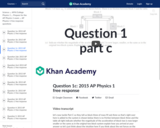
Impact of adding a third mass to our string-pulley system.
- Subject:
- Physical Science
- Physics
- Material Type:
- Lesson
- Provider:
- Khan Academy
- Provider Set:
- Khan Academy
- Author:
- Sal Khan
- Date Added:
- 04/05/2016

Impact of adding a third mass to our string-pulley system.
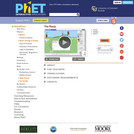
Explore forces, energy and work as you push household objects up and down a ramp. Lower and raise the ramp to see how the angle of inclination affects the parallel forces acting on the file cabinet. Graphs show forces, energy and work.

Explore forces, energy and work as you push household objects up and down a ramp. Lower and raise the ramp to see how the angle of inclination affects the parallel forces acting on the file cabinet. Graphs show forces, energy and work.
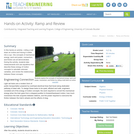
In this hands-on activity rolling a ball down an incline and having it collide into a cup the concepts of mechanical energy, work and power, momentum, and friction are all demonstrated. During the activity, students take measurements and use equations that describe these energy of motion concepts to calculate unknown variables, and review the relationships between these concepts.
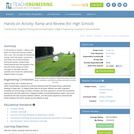
In this hands-on activity rolling a ball down an incline and having it collide into a cup the concepts of mechanical energy, work and power, momentum, and friction are all demonstrated. During the activity, students take measurements and use equations that describe these energy of motion concepts to calculate unknown variables and review the relationships between these concepts.

This article describes Katy Farness' work with the Byrd Polar Research Center at the Ohio State University. Farness used remote sensing images and computer technology to create detailed images of Antarctica and the ice sheets of Greenland.
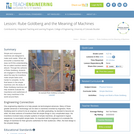
Simple and compound machines are designed to make work easier. When we encounter a machine that does not fit this understanding, the so-called machine seems absurd. In this lesson, the cartoons of Rube Goldberg are introduced and engage the students in critical thinking about the way his inventions make a simple task even harder to complete. As the final lesson in the simple machines unit, the study of Rube Goldberg machines can help students evaluate the importance and usefulness of the many machines around them.

The goal of this course is to explore and develop plans of action for improving the job and career opportunities for today and tomorrow's workforce. If we take the right actions we can shape the future of work in ways that meet the needs of workers, families, and their economies and societies. To do so we first have to understand how the world of work is changing, how firms can compete and prosper and support good jobs and careers, and how to update the policies and practices governing the world of work.
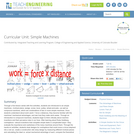
Through a five-lesson series with five activities, students are introduced to six simple machines inclined plane, wedge, screw, lever, pulley, wheel-and-axle as well as compound machines, which are combinations of two or more simple machines. Once students understand about work (work = force x distance), they become familiar with the machines' mechanical advantages, and see how they make work easier. Through an introduction to compound machines, students begin to think critically about machine inventions and their pervasive roles in our lives. After learning about Rube Goldberg contraptions absurd inventions that complete simple tasks in complicated ways they evaluate the importance and usefulness of the many machines around them. Through the hands-on activities, students draw designs for contraptions that could move a circus elephant into a rail car, create a construction site ramp design by measuring different inclined planes and calculating the ideal vs. actual mechanical advantage of each, compare the theoretical and actual mechanical advantages of different pulley systems conceived to save a whale, build and test grape catapults made with popsicle sticks and rubber bands, and follow the steps of the engineering design process to design and build Rube Goldberg machines.

Supplementary material corresponding to Wallace and Grommet: A close shave.
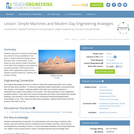
Students apply the mechanical advantages and problem-solving capabilities of six types of simple machines (wedge, wheel and axle, lever, inclined plane, screw, pulley) as they discuss modern structures in the spirit of the engineers and builders of the great pyramids. While learning the steps of the engineering design process, students practice teamwork, creativity and problem solving.
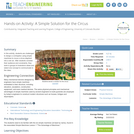
In this activity, students are challenged to design a contraption using simple machines to move a circus elephant into a rail car. After students consider their audience and constraints, they work in groups to brainstorm ideas and select one concept to communicate to the class.
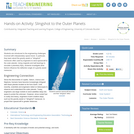
Students are introduced to the engineering challenges involved with interplanetary space travel. In particular, they learn about the gravity assist or "slingshot" maneuver often used by engineers to send spacecraft to the outer planets. Using magnets and ball bearings to simulate a planetary flyby, students investigate what factors influence the deflection angle of a gravity assist maneuver.
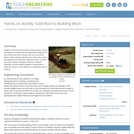
Students continue their pyramid building journey, acting as engineers to determine the appropriate wedge tool to best extract rock from a quarry and cut into pyramid blocks. Using sample materials (wax, soap, clay, foam) representing rock types that might be found in a quarry, they test a variety of wedges made from different materials and with different degrees of sharpness to determine which is most effective at cutting each type of material.

In this activity students will discuss specific work life situations as well as things specific to getting a job or during the interview process. This brings in a real life situation to the lab to enhance discussion as well as learning.

In this activity, students will begin by discussing their preferred type of work environment and typical jobs held by college students. They will then discuss how they might handle a handful of difficult scenarios at work. Students will take turns being the employee and the advice giver.
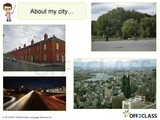
Life in the City is designed for beginner students and uses photos to prompt discussion about where they live, work, study, and have fun. By the end of the lesson, students will complete a reading activity and deliver a narrative on their own.If you want additional lesson plans and support, including teachers’ notes, be sure to register for a free Off2Class account.
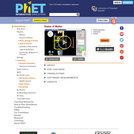
Watch different types of molecules form a solid, liquid, or gas. Add or remove heat and watch the phase change. Change the temperature or volume of a container and see a pressure-temperature diagram respond in real time. Relate the interaction potential to the forces between molecules.
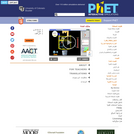
Watch different types of molecules form a solid, liquid, or gas. Add or remove heat and watch the phase change. Change the temperature or volume of a container and see a pressure-temperature diagram respond in real time. Relate the interaction potential to the forces between molecules.
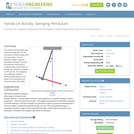
This activity demonstrates how potential energy (PE) can be converted to kinetic energy (KE) and back again. Given a pendulum height, students calculate and predict how fast the pendulum will swing by understanding conservation of energy and using the equations for PE and KE. The equations are justified as students experimentally measure the speed of the pendulum and compare theory with reality.